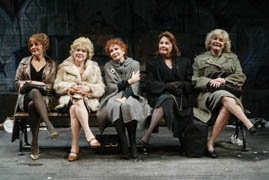
PAULANNE SIMMONS
Aging in the Life
 |
| THE OLDEST PROFESSION -- Priscilla Lopez, Marylouise Burke, Katherine Helmond, Carlin Glynn and Joyce Van Patten in Paula Vogel's "The Oldest Profession." Photo: Carol Rosegg. |
"The
Oldest Profession"
Directed by David Esbjornson
Signature Theatre Company
555 West 42nd St. between 10th and 11th avenues
Sept. 26 to Oct. 10
Tues. - Sat. 8 p.m., Sat. and Sun. matinees at 3 p.m.
$55, (212) 244-7529
Reviewed by Paulanne Simmons Oct. 2, 2004
Paula Vogel's "The Oldest Profession," which made its New York premiere on Sept 26 at the Signature Theatre Company where Vogel is playwright-in-residence, is really about five of the oldest professionals still walking the streets - Vera (Mary Louise Burke), Ursula (Joyce Van Patten), Lillian (Carlin Glynn), Edna (Priscilla Lopez) and their madam, Mae (Katherine Helmond).
These over-the-hill hookers meet on a bench in front of the graffiti-bedecked façade of the 72 Street subway station where they discuss business strategy much like CEOs in a corporate office.
The old girls have fallen on hard times. But director David Esbjornson treats them with tender understanding and wry amusement. If they have lost their looks they have kept all of their charm. And the magnificently mature actresses who play them give each of the girls a distinctive personality - from the timid but resolute Burke to the sexy Glynn.
The ladies feel nothing but affection for their aging johns who often can neither perform nor pay for the services. They face an uncertain future with fortitude, pooling their resources and taking on extra work.
The oldest profession starts slowly. Although the ladies' banter over the (excuse the expression) ups and downs of their career is clever and quick, it doesn't seem to be going anyplace. Then Lillian, a wise-assed chick from Dixie, dies and the play builds inexorably to its dramatic and thoroughly satisfying ending.
Each of the ladies sings her swan song, a raunchy blues classic, then passes over to the other side - depicted with delightful blasphemy as a grand old brothel in the sky, with a black piano player as a kind of angel Gabriel. The staging is achieved by means of a turntable and a door between the two back-to-back sets (designed by Narelle Sissons).
What makes The Oldest Profession enormously funny and touching is that these women have about as much to do with real prostitution as Star Trek has to do with the real space program. Vera wears a housedress. Mae has a concern for her girls that goes far beyond a business investment. Ursula would have made a superb lawyer. And most certainly, there is no mention of addiction or abuse - both of which plague the trade.
If these women are not prostitutes, then what are they? The obvious answer is that they are fierce and loyal survivors who live from day to day by the quick-wittedness of their brains and the skin of their teeth. Although the women talk constantly about men, the only man in the play is the piano player, a voiceless presence. These women are clearly making it on their own in a world where men have largely let them down.
Set in 1980 at the beginning of Reaganomics, The Oldest Profession tackles many of the political, social and economic problems we face today. But in the end the drama is much more personal than social.
The Oldest Profession is, after all, a reflection on the oldest and most valued connection between people - friendship. [Simmons]
| museums | NYTW mail | recordings | coupons | publications | classified |